with 🎙️ Lea Im Obersteg, Head of Global Design Thinking @ GF Piping Systems
💧 GF Piping Systems is the leading flow solutions provider across the World.
What we covered:
🌱 How Design Thinking is a powerful approach to problem-solving
💡 How it can help companies of all sizes to beef up their innovation
🍏 A walk through the stages of a Design Thinking project
💥 A counter-intuitive demonstration that the faster you fail, the better it is
🍏 The common traits and differences between Design Thinking, Growth Hacking, Agile, Kanban (and many other methodologies)
🍏 How the “Design” in “Design Thinking” may be misleading
🤖 How design thinking applies to problems that involve humans and users, not in purely technical cases.
🍏 How to design a prototype with regards to the hypothesis you want to verify
🧮 How you shall carefully select the problem you’d like to solve
🌱 How starting small is the surest way to deliver
🍏 How hierarchy still plays a role within an Innovation Project
🍎 How to avoid a cultural clash when implementing Design Thinking into an existing organization with a strong history
3️⃣ The three very actionable tools you can apply from tomorrow on to beef up your innovation.
🍏 But also risk-taking, daring, teaming up, questioning beliefs, adding the Planet as a stakeholder, and much more!
🔥 … and of course, we concluded with the 𝙧𝙖𝙥𝙞𝙙 𝙛𝙞𝙧𝙚 𝙦𝙪𝙚𝙨𝙩𝙞𝙤𝙣𝙨 🔥
Teaser: Design Thinking
Resources:
➡️ Send your warm regards to Lea on LinkedIn
🔗 Check GF Piping System’s Website

is on Linkedin ➡️
Infographic: Design Thinking
Lea-Im-Obersteg-Design-Thinking-InfographicTable of contents
- What we covered:
- Teaser: Design Thinking
- Resources:
- Infographic: Design Thinking
- Full Transcript:
- Lea’s Postcard: Schaffhausen
- Introducing: Lea im Obersteg – Head of Global Design Thinking @ GF Piping Systems
- A bridge between two Cultures
- Defining Design Thinking
- Empathy as a first step towards Design Thinking
- Finding the right Problem with 5 “Why”s
- Design Thinking is a lot about Iteration
- Design Thinking has common traits and differences with other Innovation Methodologies
- Design Thinking is a tool in your toolbox
- When shall you initiate a Design Thinking process?
- Design Thinking is a Team Sport
- How to define the right MVP in an industrial context
- Design Thinking as a Business Development tool
- Applying Design Thinking to a 219 years old company
- Is Design Thinking a Hierarchy Killer?
- Embracing Failure: a hidden gem of Design Thinking
- Culture eats Strategy for Breakfast
- Design Thinking tip: Define the Playground
- 3 Tips to Apply to day to start with Design Thinking
- Rapid fire questions:
- Other Episodes:
Full Transcript:
These are computer-generated, so expect some typos 🙂
Antoine Walter: Hi, Lea, welcome to the show.
Lea im Obersteg: Hi Antoine, thanks for having me!
Antoine Walter: So I think we shortly discussed that in our preparation, but today it’s a first for me. It’s the first time have one of my colleagues at GF piping systems on that microphone. So glad it’s you glad that I have you as the first member of our company to be on that microphone beside me, but still we have traditions.
So let’s start with the postcard today. I know where you are because we were sitting in the same room. It doesn’t happen that often. Neither we’re in Schaffhausen. Do you want to tell me something about Schaffhausen or the place you live? What would be your postcard?
Lea’s Postcard: Schaffhausen
Lea im Obersteg: Postcard? We’re in beautiful Schaffhausen.
Isn’t where I was actually born and raised. I left the place you weren’t in local? Yes. Yes. Truly local gone missing. So I currently work live in Zürich. So I do commute with the train back Tisha falls in, and I think what people love about the place and what I love is the Rhine river, where you have the biggest waterfall in Europe, the Rhine Falls.

And I think growing up here, it’s, it’s the perfect place to go for a swim. So the post gods would Bree lots of water going down there.
Antoine Walter: Well, by the way, if you come by train, you have the best postcard possible because the train really goes next to the Rhine falls. So I think that’s a good way to advocate for people to take the train instead of the car.
So, yeah, I think that’s probably the best possible postcard from Schaffhausen from my very little experience. I’m not a local, I think I say once per podcasts, that I’m French. So that’s the moment I say, I’m French. So glad study to see that I have someone who really knows, well, what Schaffhausen is all about now that we’ve made this, this very context about where we are right now, let’s introduce yourself.
Introducing: Lea im Obersteg – Head of Global Design Thinking @ GF Piping Systems
How did you arrive to this field of design thinking? What, what led you to that? What is your, your, your personal path.
Lea im Obersteg: I’ll try to make it not too long. Cause my partner always makes joke about me telling like, I dunno, I’m half of my life story, but I do think it makes difference. Understanding how I came to the job.
I was head of global design thinking. Do you have piping systems? I think what’s the initials. Bark was my work as a salesperson in the watch industries. So that’s how I earned my money when I was 18, I kind of needed to have a job and I started to work in Lucerne. Most beautiful city in Switzerland where all the tourists, mainly from China came by.
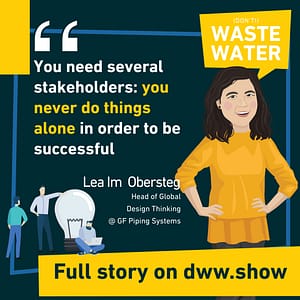
And I think that’s where I learned how important it is to get different customers, to understand what they need. It’s very different. If you sell a swatch watch to a little girl or to a Chinese party member, they have different needs, they have different wishes. And that’s really what I realized, how important it is to understand the underlying need, not just the product that they want to buy.
And I think that’s what also what made me realize how important the human interaction is when I was working at the Swiss consulate in Shanghai, I just realized you need several. Stay quarters you’re never alone. You always need to have your partners your organizations like Swissnex prohibits. Yeah.
Learning in Schaffhausen, Luzern & Shanghai
You never do things alone in order to be successful. And I think that’s the things that came together. When I was working in the strategy department of credit Suisse, one of the two majors was banks. Again, it was all about pushing the strategic agenda forward, making decisions about the future. And I think that’s really where I realized I want to have a job where you work on the future with people and also thinking a bit about the future differently banking industry.
There was little need for change back then where everything was like, yeah, well, we are now Amani money. We have all our great relationship managers. Things started changing also with investment banking. And that’s really where I started the journey to look for another position. And I ended up at least work was back in or completed GF corporation.
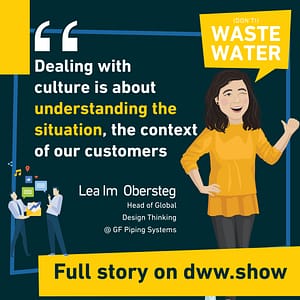
That’s a design thinking champion. And now here at piping systems, it’s really bringing that together. Like a deeper understanding of the needs of our customers was the strategic foresight on deciding where are we going? Where are we investing in order to stay competitive as a company?
Antoine Walter: So watches bank, that was a very Swiss path. And then something went wrong and you went for Piping Systems. That’s a bit weird!
Lea im Obersteg: I’m only missing chocolate. I would say.
A bridge between two Cultures
Antoine Walter: That’s true. On your experience in Shanghai with a consulate. Does that play a role as well? Because all of a sudden you’re in a different culture. How did you leave this part of your life?
What was your, your main experience there? And
Lea im Obersteg: I think I’m, I’m very, I’m blessed that I speak Mandarin due to my mother. Who’s from Taiwan. So big shout out, thanks to her. Growing up here in Switzerland with the second language really helped to get a deeper understanding. And I think living in Shanghai made me realize how, how there are similarities as well.
Even you have a different culture where you are talking about law, about not losing your face. There are still needs, and you can still tell from the expression of a know your counterpart of the mimics, the guest sticks. If the person is engaged and it doesn’t even need that much by Joe Cole to make people warm up.

But it’s really about. Seeing and understanding. And I think that’s also what I see nowadays. I’m still working with our colleagues in China, currently remotely. It’s about understanding the situation, the context of our customers. And even if it’s maybe not as straightforward as maybe with the U S colleagues, there are still a lot of nuances.
And that’s the beauty again about a design thinking approach. You’re understanding the context as a person is living in. So you’re not trying to put a, I dunno, a Swiss mentality on a Chinese customers, but you really try to deep dive into their reality, which helps if you can be there. So definitely living in Shanghai help to understand the way of living better.
Defining Design Thinking
Antoine Walter: I think we know gave several spoilers about what our conversation will be all about. And of course, it’s going to be about scratching the surface and then going a bit deeper into this design thinking. I have to say design thinking is a topic that. Touched on that microphone several times, but really touched, like we put it there and never entered into design thinking.
So I have to say, we could almost say that we’re on my end. At least we, the water professionals are still a bit Virgin or muggles when it comes to design thinking. So I’ll keep one question in the fridge, which is what you’re currently doing as a design thinking champion and head of this and thinking a GF.
So let’s come to that a bit later. Let’s start by defining these and thinking, what is it all about?
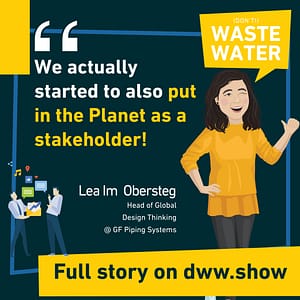
Lea im Obersteg: I’m trying not to give the school book a definition because I think that’s something you can Google afterwards for me, design thinking. Well, I Googled
Antoine Walter: it. Yes. When I Googled it, the first answer who came from Google is there is no one definition.
So I think even Googling, isn’t really giving you the directions.
Lea’s definition of Design Thinking
Lea im Obersteg: Perfect then let me give my very personal subjective definition of design thinking. Then I think design thinking is a methodology, but also a way of approaching problem solving. And that sounds very abstract. So, let me come to some examples afterwards.
I think it’s all about a iterative approach where you start with a problem statement. You dig deeper, you open up yourself to a lot of opportunities on how to solve that problem that you’ve identified. And then you come up with different ways of working in a very interdisciplinary team. I think that’s also some key component for me about the, the way of working.
You never do it alone. Like this innovator that’s sitting in his corner. I think it’s a lot about recombining things that are already out there. Based on a human needs. So I think that’s the part where does human centered innovation approach comes in for design thinking? And as I mentioned before, we started actually to put in the planet also as a stakeholder.
So for us slowly, but steadily design thinking is not just a human-centered innovation approach, but also a planet-centric one.
Empathy as a first step towards Design Thinking
Antoine Walter: And that is the concept that we discussed a bit with Denise Mall on that microphone. She was talking about ecological design thinking. I think this is an approach, which is at least in the air.
So if I get it right, the roots of these and thinking is this empathy element. You need to connect yourself to something, be it, the planets, a human, the nature in the case of biomimicry. So how do you develop this empathy? What is it all about?
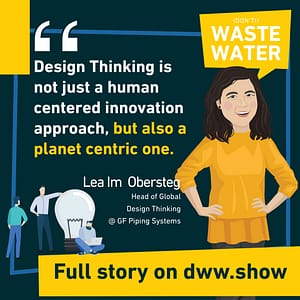
Lea im Obersteg: I think it’s great to start with empathy and no coming back to the frame, right?
To explain it to my grandma. Normally it’s thinking as a designer where you need to empathise with the future user of your products or your services. So why do you have a chair? Is it for sitting? Is it for showing off that you have a lot of money and you can afford a very expensive chair in your beautiful home?
I think that’s really where it starts empathy. A nice quote from a colleague yesterday. He he’s about to retire. He’s been working in the company for 40 something years and he said, oh, I hate these people that studied innovation, right. They don’t know how to do innovation. And I think he has a point. You can learn a process.
Empathy can’t be learned, but you can practice it
You can learn a way of thinking, but empathy is something you need to practice. Every day, you can start with your partner, your kids. Yeah. Your family. And it continues with your working colleagues and then it goes out to your customers. So listening, I think I’ve mentioned many times in a lot of conversation it’s about truly listening and not already have an answer in your head.
So when have you really listened to a person without starting your sentence? And there was a nice discussion. We had a few weeks ago, if your steering committee answers after two seconds, once you finish your pitch, they already had their answers ready for why you were pitching. And I think that’s really where this emphasi part starts to endure the silence.
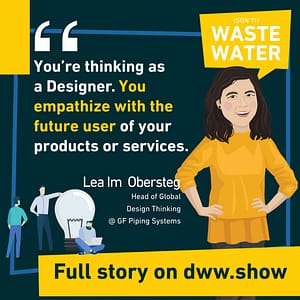
It’s not about giving an answer, but really trying to understand, okay, what’s the reality of a, let’s say a planner that is designing a new building. And not just trying to give him the solutions, but start to understand the problem. So yeah, I think a small tip. No, what I try to do every other day is enduring like a five second silence and you’re listening and that’s pretty long.
That was five seconds. And only then start to make sense of what the other person said. And I think that’s that’s where empathy starts. Yeah.
Finding the right Problem with 5 “Why”s
Antoine Walter: So that has this element of active listening. I guess it’s not everything about the design thinking methodology, but that’s the start. If I get it right.
Lea im Obersteg: I think it’s really this core in order to dig deeper again, that’s also one of the no asking the five whys.
It’s something you, you Google again and said, yeah, ask why
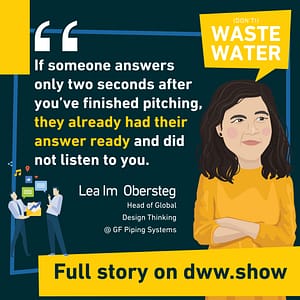
Antoine Walter: I have a two years old daughter. So it’s not five, it’s like 5 million wise, but it’s true that at the end, you end up always talking about the universe because the root of it is,
Lea im Obersteg: and again, it goes similar into understanding a user needs. Right? Is it a, do I need a piping system to transport liquids or is actually the job to be done on your customer sites?
It’s ensuring that your entire system is running or is it actually as a installer that you just have zero downtime? And then you go deeper and deeper and deeper. I think that’s really where the beauty then comes for us as a company then to take these insights and do something with it. And that’s normally the biggest or most difficult part is to say, okay, now we take a decision as a company to try to solve certain problems and not all of them.
Understanding your target’s problem gives you a competitive advantage
So focusing on a few things that really matter to the customers and make competitive advantage is something that’s challenging as well, because we live in a very competitive industry, right? I think after all your podcasts, you’ve seen that. And it’s really about what are the customers willing to work with together with you?
What’s another womanly about the money parts or, I mean, costs is something that’s always the discussion, but what can you bring to the table that the counterpart says, okay, no matter what you helped me. And that’s why I want to work with. And all of a sudden, you start talking about other things than just the cost and why we are more expensive than our metal competitors.
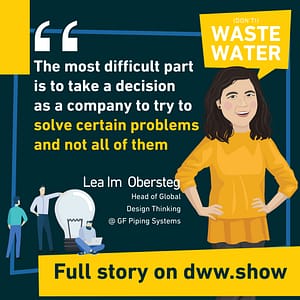
Antoine Walter: So it starts by identifying the problems so that it’s this active listening, the five whys and going read to the root of it. And then once you have this full wealth of problems, you then pick the one which are the most pressing probably, and try to solve. Then also the one which passed to what you can solve yourself.
And you mentioned the iterative aspect of things. When does that come in play?
Design Thinking is a lot about Iteration
Lea im Obersteg: I think iterations are at the heart of it. And it’s again, something that’s maybe a bit counter-intuitive coming from a traditional product development in an industrial company. You normally also do know you do some first prototypes.
You have an idea, you go into the 3d printing and then you develop a first mold and you go out into the market and what the entire. Design thinking methodology is telling you is start small, do lots of very rough prototypes and the prototype can be just literally a sheet of paper and it can be a mock-up on the screen.
And there had already starts because you’re all of a sudden see that your great idea has many flaws. Actually. Now you’re like, okay, what’s the next step? How do people actually make decisions? So the prototype, I think, compared to a technical prototype where you check the functionality is actually testing the way, how decisions are taken, how your customer is approaching a problem that they have.
And through this discussions and many, many discussions, you come to a better solution. I think that’s the iterative mentality that goes through the entire cycle because you, you become more and more concrete. And I think that’s the next myth about design thinking. It’s not about never ending beautiful cardboard prototypes, what?
You start with a piece of paper you’re going to cardboard, then you’ve become concrete. And the more money and time you invest, the better the decision should also be. So it’s also about making better decisions along the way and not, no, as you, I don’t know. After three years of development to say, oh, we stop the project.
Design Thinking has common traits and differences with other Innovation Methodologies
Antoine Walter: I think that there’s an element of MVP in what you just said, which I’ll put together with my other question in the fridge, because that’s something I want to delve a bit deeper into it, but right before you mentioned job to be done, which I also read as a methodology, the job to be done methodology, you have the lean startup methodology.
You have a growth hacking as a methodology. You have agile by certain aspects is. A similar methodology. And then you have design thinking. Is that all different names for the same thing? Or do you have major differences between all of these words? Why is it’s the place where apply in the process, which is different?
What is your take there?
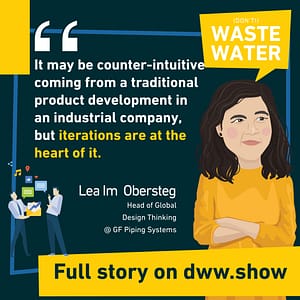
Lea im Obersteg: I think we, as a company back in, yeah, 2000, I think 16, or even earlier with our previous CEO, Yves Serra is now president of the board, he made a very strong, bold move while working with Ideo to say everybody at the company should be customer centric while innovating. You could have replaced design thinking with a lot of different innovation methodologies.
Design Thinking’s special kick: being human-centered
What’s for me, the biggest difference is really that human-centered. You can work on an agile methodology, also ignoring a bit more on all the customer sites or you have kind of the user journeys, et cetera. So in all these different methodologists, you do have similar patterns. And that’s also what I often say.
Yeah, I’m not the method and path pops in German, so I’m not like, okay, you have to do it exactly and like that, but really right. I think what’s, what’s important for the project to be successful. What’s needed to come up with a business case. You have to work in an agile way in order to be fast with decision-making.
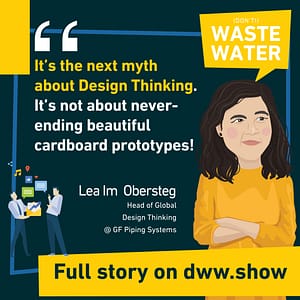
So our project team meets weekly. You take decisions, you have kind of clear tasks. Kanban board on where you work, but I would say, oh, we’re now scrum because it’s again taking the best
Antoine Walter: exactly. Which I didn’t mention
Lea im Obersteg: that. So I think that’s also the, the beauty and the hatred about these innovation methodologies.
It’s not about doing them or following a strict process, but it’s more a variety of things that can help you to make better, faster decisions as a company.
Design Thinking is a tool in your toolbox
Antoine Walter: So it’s tools in your toolbox. And then as long as you keep the user-centric approach or planet-centric approach, you’re probably right. And
Lea im Obersteg: the best yesterday I was the working session.
Best slogan ever, a fool with a tool is still a fool. So if you’re not willing to open up to challenge the status quo, I can give you 10 or 20 tools and you will still come up with the answer that you want to hear. So I think it really starts, and I have a lot of discussions about that. It starts really with the mentality, the mindset, the DNA on how you, as an employee of a company approach things.

Have you already fixed your solution, then I don’t need to give you any tools to work on. If you say, actually now we need to develop a new solution because water becomes more scarce. Okay. Let’s have a conversation and let’s think of how you can figure
Is the “Design” in “Design Thinking” misleading?
Antoine Walter: that out. There’s one element. If it’s a tool and we’re not fixed on design thinking itself, when you tell me design thinking, you know, I remember when I was a kid and my father was saying, Hey, that’s designed for him.
That would mean it’s nice. It’s beautiful. But it’s probably absolutely unpractical, but it’s nice. So if I get it right, it’s design thinking is about the exact opposite. We don’t care if it’s beautiful, we want it to be very practical and to be very catered to the user. Is it doing a service to the full methodology and the approach to still call it design thinking?
Did you have some pushback from people saying why design.
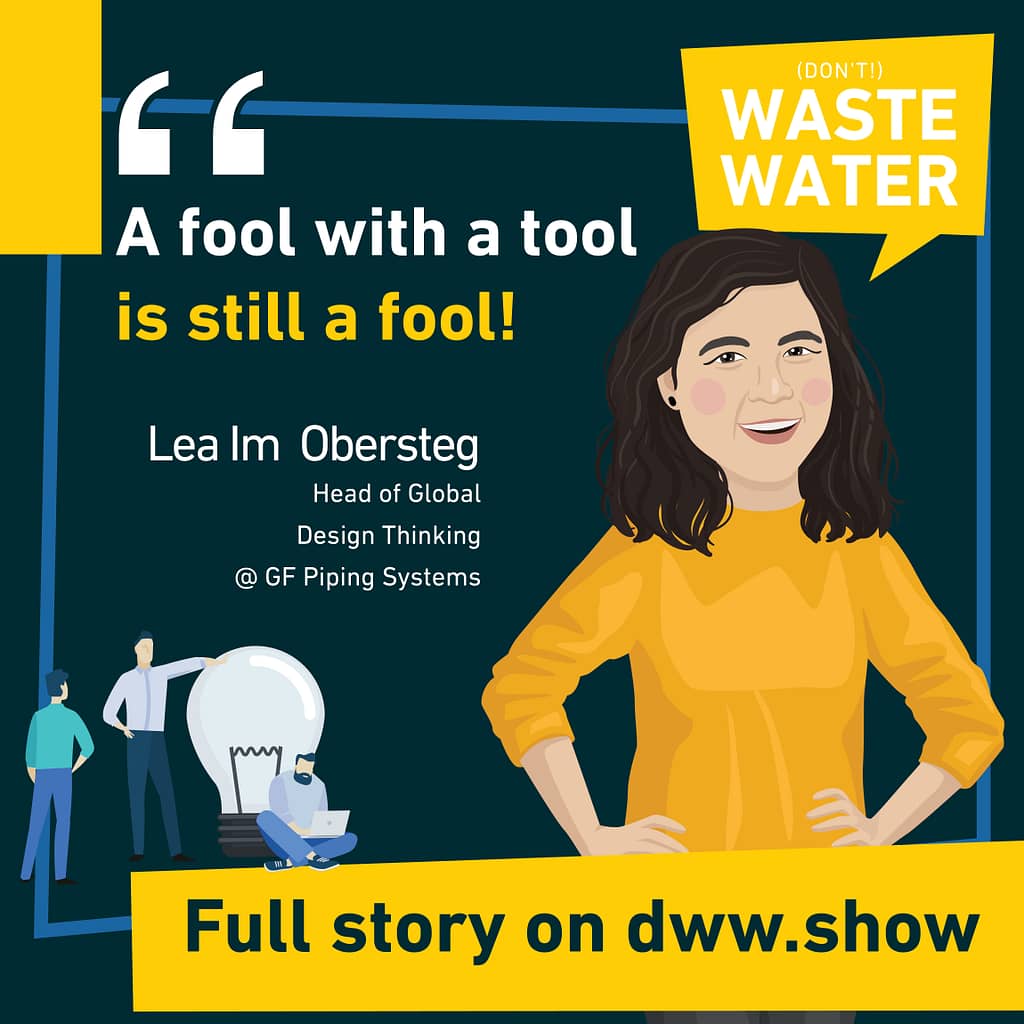
Lea im Obersteg: Especially in China. When I tried to translate it into Chinese, I had many big kind of discussions because like design is such a used term. Now it’s like, I don’t know law, or I don’t know, being a doctor. Everybody has a mental note, a picture in, in the hat.
I think what’s still, the beauty is about, no, again, that empathy part. And then looking into the question in the fridge about the MVP, thinking about an MLP, we said minimum lovable product. It really will help the success of your product, of your service. If you have fans in your customer base that are willing to buy something.
Beyond the name, it’s a methodology
So I, I love to steal the basic idea about design, to understand what’s the need. And again, the thinking part, somebody had to come up with that name. I think it was in the sixties where Ideo made the whole methodology a bit more mainstream. No, I think if you do a research on Google on publications, there is definitely a spike in, in the last 40, 50, 60 years where companies realize that that may be one of the ways to help them to stay competitive in the market.
Again, it’s not the only solution. Many discussions here also with our management team, it’s not a magic pill that you can just swallow. And all of a sudden, everybody becomes very innovative and we have this 30 million opportunities popping up. It’s more about in the everyday, having everybody along the value chain from our sales colleagues out in the market from our R and D teams, really thinking, why am I designing something to again, bring in our colleagues from marketing to make the storytelling, right?
That’s for me, the real transformation where we as a company are really on a, on a very good journey. I would say
When shall you initiate a Design Thinking process?
Antoine Walter: very practically speaking. When would you use these and thinking, what is the trigger you see out there in the environment who say, Hey, that is the point of time I have to start using. I like
Lea im Obersteg: to take two aspects into it.
One is, is there a human problem? Is it solely technical? And you already know everything out there, then no need to kind of go very deep into the discussion. You remember complicated versus complex. So if you have a complicated problem, meaning you have problem a, you know, you need to build a car and you know exactly what to do to build a car.
You don’t need to question the car, building the same here with an existing valve. If we know everything, you don’t need to go into all details. However, if you have a complex problem where you’re like, how can we survive and help our customers to build more sustainable solutions to save water there, you have several complex aspects, right?
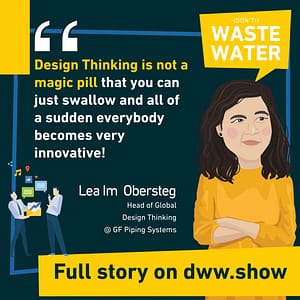
How do you save water for whom are you saving it? What’s the things that are there. What’s the possibilities to go beyond. And their design thinking can really unleash its full potential. And that’s also a big discussion we have here in the company. Like, have you done design thinking? It’s one of the most stupid question.
Design Thinking only works if there are humans involved
It’s more, have you thought about your users? Have you worked in an interdisciplinary team? Have you used the data gathered for decision-making or did you take your decision because you already knew it and that’s the discussion that I would like to have rather than saying you should do it or not. We have a lot of colleagues.
I do some coachings once in a while in communication or in HR, they come and say, we want to redesign the website. Do you have an hour? I just want to make sure that we, you know, involve all users. We have a new talent management program. I just want to ensure that we have covered the right personas. And that’s for me a beautiful way of applying design thinking.
Even if it’s not the next, no, again, 30 million thing coming up, but maybe who knows if an employee gets the chance to bring in their ideas. Probably that’s the next big, cool fit program that we’ve launched. And I think that’s really where design thinking should be applied.
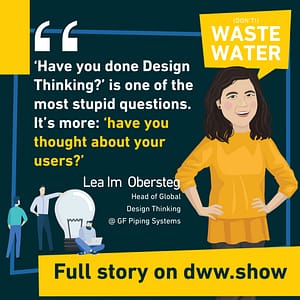
Antoine Walter: So design thinking is not a gatekeeper.
It’s not one of these gates that you have to undergo. It is, as we said before, a tool in the toolbox, which is here to remind you to put the user at the center of everything that you’re you want to develop.
Design Thinking is a Team Sport
You mentioned now several times the multidisciplinary aspect of it does that mean that if I go out and start discussing with all my customers and try to put them at the very center, but I do that all alone, that I’m wrong.
Lea im Obersteg: It’s better. You do it by yourself, then not doing it at all. Definitely. I think again, where the full potential is unleashed is when you, when you come back and you have a team of maybe experts, but also maybe people that are not too deep in the technical part to come together to make sense of the data you’ve gathered, because you have a perspective, you can be no, as we said before, as open and as wondering as your little, um, kid.
At the same time, you still have direction because you call them no one business development side. So it’s actually important for the process to bring in also people from a different element, product management colleague that really knows the market well, bringing in a technical expert that will help you to understand what’s feasible or not bringing in a customer research expert that will really say, have you degree to deeper, or is that actually an answer that you want it to have?
That’s why you asked the question. So the head, the team will help you again to make better decisions.
How to define the right MVP in an industrial context
Antoine Walter: Let me take now out of that fridge, this elements of MVP, which in between became an M L P because your definition is minimum lovable product. My question here is that we are in an industrial context, right?
On that microphone. We were regularly discussing about what a company’s developing processes. Sometimes the technology that comes from the international space station and is brought back to earth, sometimes something which is, we’ve all been done that way. And then we take a new turn on it. And here I have a hard time figuring out that with mock-ups and cardboard, I can already have something where my user can grab it sufficiently to extract valuable information about what I’m currently developing, how wrong am I with that preconception.
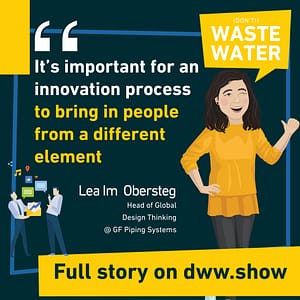
Lea im Obersteg: It depends a lot on the stage of where your project is. So again, if you take no industry company piping systems where we are, there will be a moment in time. Even before starting a technical development, that we’re still searching for the real problem and a cardboard prototype. As I’ve mentioned before, can help us.
It’s more like a mean of communication. It’s a provocative thing to put a cardboard prototype in front of an investor and having them speak and make sense of what they see. And these are then the informations that you can take in order to make your technical development better, because you understand that safety is a huge concept for them.
They couldn’t care less about the design or the opposite way. Actually design is very critical because that element is shown in a pump room in China, where actually it’s a lot about showing face again.
Prototyping breaks a pattern and helps you define the core of your product, service or solution
So the design extra plays a bigger role, maybe then the different parameters. Or you put them as a mock up prototype with several sensors element and they will tell you what they really need versus what’s a nice to have.
So yes, it’s pretty provocative to put these prototypes out into the customer’s reality. We had a project with building technology last year, where we had an interview with a customer via teams, as we often have. And just by clicking through a mock up that we’ve designed through a few hours in the morning, we get are so much more information.
Or there was an example where we had a 3d prototype of a wall for our utility business, where there were some holes, some holes, and the customer said like, what are these holes for? And then number one, if there is something to remember from today, ask back, don’t give the answer. So the interview for our team, she asked back, it’s like, what are these holes for, for you.
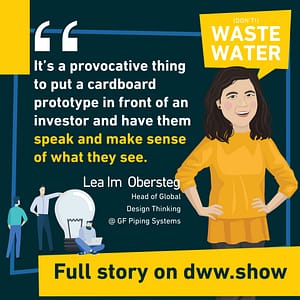
What do you see in these holes? And then the customers came and said, yeah, that’s actually like a hook, right? Because you could insert a hook because the valve is down in the trench. It’s 30, it’s hard to get. So actually something to, to lift the valve and we were all stuned in there. It’s like, well, that’s interesting because we thought about sensors.
So we realized again, if you create something for the utility market, which we know already, it’s really important because the real life conditions are so different from our R and D departments here, maybe in, in beautiful Schaffhausen.
Get honest feedback on your Idea in its simplest form
Antoine Walter: So that means that this prototype element is almost breaking a pattern.
You want to strip down your, your Idea to its simplest form so that you don’t distract the user with something which might prevent him from giving you his real truth. But how do you decide on the right size to go with your minimum? Because minimum means it’s still not nothing. It’s something. So how do you size your, your prototype?
Lea im Obersteg: Again, that’s really something that you can’t get out of a book to saying, okay, at this stage, you need to have that prototype. It really depends on what is the reaction you want to trigger? We have to the law also currently in the current project where it’s all around circular economy, what do we want to figure out?

We’re very broad at the moment. So we realized that our prototype there’s so many aspects and it’s like, okay, that’s probably a bit overwhelming. So we need to come back and define the set of hypothesis that we want to test. And based on that we define which elements the prototype needs to have in its core.
Design Thinking is a lot about defining the right hypothesis
If you’re pro or hypothesis states and the uncertainties you still have, or mainly on the technical side, then focus on the technical elements. Right. Whereas the switch need to be know what’s kind of the connection, et cetera, right? If that’s the only thing missing. However, if you’re more targeting uncertainties regarding market requirements, you can go into having a prototype all around.
Okay. No. How do you access your market? What are the channels? Making a customer journey and asking them to, to rate actually what’s true. Now, do you go through a distributor? Do you go through your local dealers? Do you do direct selling? There is no right and wrong. Look at your project. Look at the highest uncertainties you have and the information that you need and design the prototype for these element.
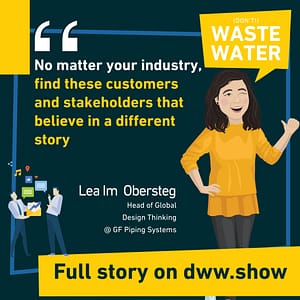
Which I mean, never ending learning, right? It’s something we both share. You never stop learning. There’s always parts where you come back from a testing and said, we should have asked this and that. And that’s the beauty about iterations again? So, we, we have in the current project, we had three weeks of first round of interviews.
Now we started with testing and every week when we get new feedback, we can actually adjust the prototype on the fly once we’ve verified or falsified one of our hypothesis. And that needs guts. I can imagine
The trick? Never stop learning!
Antoine Walter: you mentioned the never stopping to learn. There are two elements in to that. The first is as much as I love the Idea I’ve discussed on that microphone with Paul O’Callaghan, who wrote a full thesis about how long it takes for water innovation to go out there in the market.
And what he was showing is that even the most successful technologies, they are take 30 to 40 years to get out there in the market and to, to reach mass market. So that means that there’s also full wealth of other technologies, which simply leave there somewhere and never reached that mass market. So what I want to underline here is to kind of.
Conservative nature of that industry. And when preparing for our discussion, I read that that’s sometimes a major barrier to design thinking. And the, the example that we’re giving in the literature I read was about healthcare. The saying in healthcare, you cannot take the risk to go out and put something which might be too innovative or going really against the habits because there’s life on the line.
And that is something we share with the water industry. If we make something really fancy, which might be very, very promising on the long run, but in between you get to water at your tap, which is of a bad quality, then you have a big problem. So how do you overcome this element of the conservative aspect to still, not limit your creativity, but on the same hands, stay reasonable.
If that’s possible.
Design Thinking as a Business Development tool
Lea im Obersteg: Two things I learned from you, the bird, the beautiful word Chasm. Right. So really thinking about the early adopters, your early fans, the ones in your industry, no matter, it’s not a water industry or the healthcare industry to really find these customers and stakeholders that believe.
In a different story and start small. I think again, if we say we want to know change, the whole word would be sitting here and drafting a plan for the next 40 years and don’t do anything. Always start to try it again, to emphasize with our kind of lead lead users and see what are their pains. And that can be sometimes very small things to lead to some quick wins.

And then also having that bigger vision in mind and no designing backwards, saying, okay, what is needed to make that vision happen? Who are the regulatory bodies that we need to go on early? Who are the decision-makers in that field? And I would like to take an example, actually from the healthcare industry, I’ve talked to the founder of CUREiosity.
A practical application of Design Thinking
So it’s cure from curing and curiosity and the startup founder. He said it takes a lot of. Patience years again. Yeah. It needs perseverance to show these examples. So it’s all about using VR to use with stroke patients with all timer, with Parkinson, with Ms by actually showing them. In a VR reality, how the body parts could still be there and they start to use it again.
And again, it’s something that takes a lot of time. No, for the patients to practice, but our brain is super intelligent. There’s so much things wired and something we can learn. Again, I think that’s a beautiful example where this is one part and it’s the user need. It’s the patient that has a problem. And then starts the heart work.

You need to work with the Lahey clinic. And now with the recovery centers, you have to work with the doctors. You have to work with the insurance companies. You have to work with the end users as well. And you have to work with the nurses. And he showed that because you just mentioned it. It’s a beautiful example.
You can break (almost) any pattern
He said there was a nurse that was been working in one of the clinics and said, no, ah, yet another innovation. I mean, they know they pass our place every other day and she came back and. 30, 40 years, that’s the first time that she saw a technology that really helps the patient. And that’s the same, I would say, in, in, in water industries to find these people that believe in it and really find the real problems that there are, there are many things, and it’s also about not coming and saying, oh, everything is wrong.
That he did. There is so much tradition that we can be really proud of. So start with that, see what other things work and see how we can add to that.
Applying Design Thinking to a 219 years old company
Antoine Walter: I think that resonates quite well with your concept of minimum lovable product in what you explained around how you need to have those first users that really love it.
And again, that’s a clear bridge with, with growth marketing, which is all about narrowing down and finding the user for which what you are developing is gold and then rebuilding from there and to, to reach mass market. Now there’s one. Elephant in the room. We are both working for a 219 years old company, and I’ve said the market in general.
And I’ve been very generic to say that, yeah, you know, people can be reluctant. I mean, let’s be now very concrete in our company, GF piping systems. If you come and say, Hey, we want to change the way that we approach innovation, we want to bring in this new methodology. What was the first reaction? Was it, oh God, we were waiting for 200 years for that.
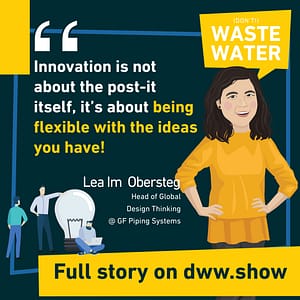
And we’re glad it comes. Or was it like, Hey, we’ve been working for 20 years for 30 years, for 40 years. And we’re very successful. Why shall we change something?
Lea im Obersteg: I think naturally if there’s new things, it’s always like, okay, yeah, prove it first. Right. And always see how it goes. What I like about the GIF mentality is people generally open and we have been successful.
So again, if I talk to our sales colleagues out in the market or product management here, we are successful and everybody’s giving their 150% every day. And I think that’s a great basis to start to work more and more on innovation.
How to make a great thing greater
And that’s also the approach that I, as a person like to take is I’m not coming and saying, please Antoine, stop what you do.
It’s it’s more, how can I help you to make your work better? And again with growth marketing. I’ve never tried to bring everybody to the table and say, oh, you have to like it. It’s more, again, we’re in the company or people that like to work on things and they can have support. Where are the people that believe in a project, in a challenge that we have and let’s work together, make it concrete, no mitts make a business case together.
Let’s work on an actual challenge that you have. And that’s where I believe strongly that this change can happen. People talk about a lot about know who bought projects. So kind of Marines that go through. I’m not a big fan of trying to hide everything and come up in three years. It’s more about finding the right people in the different departments and the different business units to say, okay, let’s, let’s do something.
And that’s where kind of the whole thing comes, which no, you say failure and learning from failures. When I was working at corporate, we started a lot with awareness. The topic was mainly about creating awareness and we did a lot of one day trainings and people loved. It was like, oh, beautiful. Post-its but you couldn’t be far, far away from the reality.
Innovation is nothing about the post-it itself. It’s about being flexible with the ideas you have being able to reconnect. And I think that’s really, what’s more important than sending everybody in, in to kind of a session where you learn how to use the posted. It’s the mentality.
Design Thinking goes beyond the Post-Its
Antoine Walter: Good that you mentioned the post-it, because I think that that’s the other big image of design thinking, which I didn’t give so far, which is that yeah.
It’s all about post its on the wall and that’s a part of the methodology, but the methodology is not about selling or using post-its. So. One element that you, you shortly explain that four was the example of, Yves Serra. So the former CEO of GF that brought in the methodology and the thing which, which I don’t get here is, I mean, you’ve seen that video probably 50, if not 500 times of Ideo developing a new shopping cart.
And if there’s someone listening to that, that didn’t see that video, I’m going to put the link in the show notes,
but I’m absolutely sure that you’ve all seen that at least three times. And to me, the outcome of that video is that it’s a very flat hierarchy. There is no real boss and employees. Oh, you disagree like that.
So if you have now a methodology, which is brought in by the very top of a company, like it was the case here with Yves Serra isn’t, it’s kind of the opposite to what you want to achieve in the long run.
Every Change needs multiple layers
Lea im Obersteg: I think every change, no one I’ll come in a bit more from my sociology and also from my management innovation background, every change needs multiple layers.
And that’s what I wrote my thesis about it. Funny enough, it was about a legacy of new organizational innovation on the topic of Holocracy self-organization right. It’s like, whoa, why would you do that? The beauty about this changes, it needs all different layers. You do need to have a top-down support saying yes, we are willing to give our teams more decision-making power.
They come up with a proposal and yes, we are a company that’s working now with hierarchical levels. You still have somebody that takes a decision, whether it’s a business unit no, as Jens Friesenborg. For example, we do with that methodology, give our teams more means to create a dialogue with the management, to have a better decision.
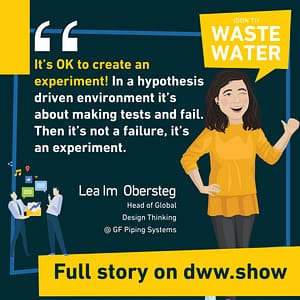
It’s different. If you come with a business case with very beautiful figures out of an Excel, oh, you actually have information from the market underlying the business case you’re doing. So I think that’s why you need to top down approach of people trusting into the project. And also being able to cope with that uncertainty willing to take risk as we did with Oxford flow to say, okay, let’s invest into a technology from a startup.
Now we have to figure out all of the pretty neat details on how to integrate it. And it also needs the bottom up where people need to take more responsibility. It’s hard to hide in a project team that really wants to push things. You need to have these discussions to conversation, not on your personal preferences, but really debating on what the data tells.
Is Design Thinking a Hierarchy Killer?
Antoine Walter: So that was your very corporate answer. No, no I’m being mean here, but I’d like to, because I saw your face when it was mentioning that Ideo was a flat hierarchy. So you disagree with that.
Lea im Obersteg: It depends on the organizational design. You have for your company here compared to the Freitag bag as an example, where they put in a Holacracy where you have different circles and within the circle, you have experts that decide for themselves.
They do consult the rest of the circle, but they do to decision versus at GF, we still have structural. We still have for every project, the steering committee. So as long as we have that structure, it’s never a flat pirate. You maybe have a flatter hierarchy in the project team because you see every subject matter expert has a voice.

And if I’m now an idea lead, so putting a project to the next level, it’s not me deciding alone on what we do next, but I consult the team. I consult data that we get her. And based on that, we put in a decision as a proposal. So it’s the same with the shopping chart example. There is still the management of that, a supermarket coming to decide if they do it or not.
Hierarchy is still there, but in a different role
So I think that’s something that’s a very nuanced that this video is actually not showing. You’re still embedded into an organization. The reality same here at GF. I shared the example with you last time, right? We are a company that has tradition. So also shareholders expect us to have a stable return on invested capital.
So we probably will never go. Beyond craziness with all our ideas at the same time, they also expect us to stay innovative, come up with new ideas because that’s what made us successful the last 200 years. So my corporate answer 2.0, oh, we still have the structures, but again, it’s a much lower hierarchy because I can ask and talk directly to a business unit head and an intern can be part of a project and has in his role as a subject matter expert, a pretty important voice also for the project.
So yes, there are less hierarchies because yeah, the decisions are made differently. Definitely.
Embracing Failure: a hidden gem of Design Thinking
Antoine Walter: We scratched the topic of failure and that is the last big stop I would see, which would prevent people to go into design thinking. I mean the old, traditional way of doing innovation that you develop everything and you, after three years, you put it out there in the market.
Sometimes it’s a big hit sometimes it’s okay. Ish, but it’s never like, oh, it’s rarely a big, big, big fader. So it’s, it’s quite good for your ego. Probably not a good return on investment, but it’s quite good for your ego. And now I’m going to make an exception and tell twice in the same podcast that I’m French.
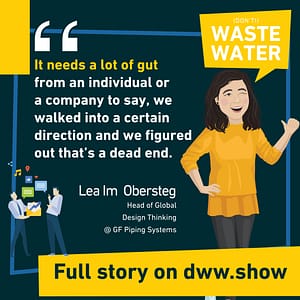
So to take an outside of you, we are working in a Swiss German company with a lot of this German culture. And I would say if you add that additional layer of Germany SMA on top of the, the traditional way that business don’t want to fail here, when you fail, you not only fail, you also lose your face. So how counter intuitive is it to now tell to those same people, you know, what you shall fail, you shall fail fast and iterate from your failures.
Lea im Obersteg: I think, especially in this Swiss German culture as well. I mean, failure on my that’s something you like, you learn as a little kid: “Mach Kein Fehler!” So I think and I think even in Chinese, there’s not a lot of words for that. So I think it’s, it’s not in the human nature. Sure.
Failure can be difficult, culturally speaking
Antoine Walter: I think you’re an interesting mix to that extent, because I would say if you ask me to name two culture, which hate failure, that would say German culture and Chinese culture.
So you’re a mix of those two failure averse cultures, and still you’re working these and thinking you must be really crazy.
Lea im Obersteg: So my non-corporate answer to that, it is really about giving the people again, means to learn and think we had a huge discussion here in the company now about different failure types.

It’s okay to, I don’t know to, to create an experiment. No, where we have in a hypothesis driven environment, what’s design thing is all about to make tests and fail. And then it’s all of a sudden, not a failure, but it’s an experiment. That proved a or B and as something I really love is actually reframing the word failure because there are some things.
Now, when you have a machine, you have to ensure that the things are running. If you’re working a nuclear power station, there are some things no, where people need to learn with pressing the button. I love that example of somebody in quoting people had to learn to say, you rather press the red bottom once too often, then not at all.
Failure Vs. Hypothesis
And then you screw the things up. So that’s a very different environment. Take decisions, making failures versus in a innovation driven environment where you ideally actually have hypothesis you want to test. And that’s also what I would love to see in the conversations we have is being very honest about very tiny failures we have now.
And then. It was two weeks ago. It was a stupid example, but we were organizing interviews for our current project. I was trying to organize five, six different meetings internally and externally, and everything was settled. Then I was like, and I got a call from all of our sales colleagues. It’s like, where are we supposed to have a meeting now?
So I forgot to invite the expert for the expert calls, which is something so small. And so not, no, that’s not a very important failure. It’s at the same time. So important to talk about all this human flaws that we have and showing that it’s not bad in order to prevent bigger fails. And it’s the same in projects.
Failing Fast saves you big on the long run
It’s very hard to work on the sunk cost that you had because nobody wants to stop a project that everybody actually knows that will fail. And that goes back then to the trust in the company to say, oh, we data-driven India. Like w we have no, we have the feedback from the market. Are we still willing to do that?
Everybody says it’s not what they want always to pushing it forward. We have to test back, know that the technical components, it actually needs to prolong because I don’t know the material is not ready. Always, still trying to push it forward. Or do we, as a company, take a bold decision and say, let’s stop it.
So yeah, we could do another postcards just on, on failure. You have to be aware of the environment of the culture that we are in and making concrete examples that people can start working with that concept. I think you
Culture eats Strategy for Breakfast
Antoine Walter: just pronounced the word, which is key here, which is culture. I think we both heard that sentence so many times that culture eats strategy for breakfast, but that, that, that pertains very true.
And if you have this culture, I just read an example. I think it was yesterday about cholera in the beginning of the 20th century quarter, what was believed to be a disease, which was spread by. And it was written by the law in France, in Germany, that it is spread by air. And there’s, there was one guy in the UK that said, no, guys, you’re wrong.
It’s spread by water. And that guy for a decade was considered as, as a mad, as crazy. And he persisted and he was able at the end of the day to prove he was right and everybody else was wrong. When you tell this kind of story, then it gives you this impression that you shall take all your projects and push them, push them, whatever you hear from people, because go on, keep pushing.
It’s going to be right. Whereas with what you said about early failure is exactly what you want to avoid. Not that you want the guy who is right to stop on the way, but you want him to make him so many small experiments that if he’s right, he gets approved every second week that he’s on the right path.
Creative Confidence: A useful tool for Design Thinking
So that at least he knows why he keeps pushing his project. And where I’m heading with this very long question is I read another book, which is called creative confidence, which is written by the brother Kelly. One of them being the founder of ADL and the point they have in the book, which is very valid, is that you need to be confident in your ability to be creative in order to be creative.
It is a self creating process to be creative. So now if you’re failing every second day, because you’re following the process and you’re doing, you’re doing read the right way and you’re trusting the process. Don’t you come at some points to a moment read you’re thinking, well, all my ideas are crap. I better leave innovation to someone else.
Lea im Obersteg: That’s very, a very deep question for a lot of different aspects and trying to figure out which one to pick out of it. I think there’s two extremes, as you just said before. I think what we want as a company is that our people do have an like an entrepreneurial spirit. So they believe in a cause they know, take up the sword and she’s running into kind of the future.
Design Thinking tip: Define the Playground
What as a company is important is also that we have a clear strategic direction where we go. So defining the known play fields for our people to go crazy. If we decide we don’t want to go into a, I don’t know, Water in on the Mars. Okay. Well then we know what’s the playfield, right? That’s before even starting because we’re in a company, we are not the guy who has cholera, which is bad enough.
As an example, we have to define kind of more or less the boundaries. How willing are we to take risks? And do we have no, do we have a Pope where we say, okay, we want to work on transformational stuff. That’s maybe only 10 years, or do we say we want to work on just sustaining the core and that’s a call to make.
And out of that, you can then tell your people know, Antoine is a business developer, go ahead because water treatment is the next big thing. This is kind of the playground you have. And within that, you need to have both aspects. You need to be the guy that believes in the thing. You ideally have a team around you that believes at least in the vision as well.
That helps you to overcome all these uncertainties along the way. And again, it needs a lot of gut from an individual. As a company to say, we walked into a certain direction and we figured out that’s a dead end. And that’s something that’s hard again. Right. As a Swiss company, as a 200 plus years old company, it doesn’t feel nice to say let’s stop something we’ve been doing for many years.
You can strategically think through your path to design thinking
So that’s really where the strategic aspect comes into play again to say, okay, what’s the direction we want to take anyway. And within that, you need to have the confidence as an individual, but also as a company. And then again, you need to have that. I don’t know if you don’t see the podcast, the thing, no, like the clause to stay on, on the thing and to say, okay, whatever, I I’ll buy it.
And that also, where, where does the ego part comes in? No, don’t put your ego in the center because then you keep on pushing things that actually everybody tells you, look, don’t do it, but also have that net of decision-makers of project team members that would say, whoa, okay. On time, please stop it.
Seriously. That’s stupid. And yeah, last, last but not least. I think when we go into this way of working it again, depends on which stage you are. We talk about front-end innovation, early stage ideas. We also talk about execution and once you’ve decided on something, don’t start to question everything from zero again, but really no focus on the project plan, focus on the nitty gritty details.
And that’s also a mentality shift also, or sometimes other people, not everybody is the best push things forward person. Not everybody loves to deal with Xcel. So also come up with a team that knows which stage you actually need to push the things forward.
3 Tips to Apply to day to start with Design Thinking
Antoine Walter: I’d like to close that deep dive with some tips.
If you have some tips to share, if people wants to not become an expert in design thinking like you are from day one because I guess that’s there, there is a learning curve, but want to implement some elements of design thinking to improve their way of working gradually, what would be like your top three tips that they can start using just after listening to them?
Lea im Obersteg: Let’s summarize from the start. I think the one part we said, it’s really this deep listening, especially when you don’t understand yet what the problem or the solution is, just kind of start with asking the questions also to the right people know. So do your stakeholder map think about to potential customers, think about the customers of the customers and also the different partners you have.
Again, we’re still in a, in a human centered world yet. Let’s see what the next 50 years will bring those robots, make the decision, but really think and create that landscape for you. Who are the decision makers in the organization? Also the informal ones. Now, is it more to sales? Is it more marketing?
Deep Listening, Involving your Partners and listening to your Guts
Think about the external. Partners you have, and also the ones that you don’t have as a contact yet it needs a lot of guts to call up cold, cold people and say, Hey, I think you’re important to make my business happen. Can I talk to you? So listen, talk to your people then in the known and the future partners to be successful.
And third one is trusting the gut feeling sounds very, you know, hugging trees and everything. We, humans are all based on our experiences and everybody brings that to the table. So scanning, understanding where the data is coming from and then asking once I’ve really honestly, is that something I believe in, shall I continue?
Is there somebody that is missing on the journey? Do I need to have another talk with that person when to stop and when to continue to fight? I think we have a very, no elevated over millions of years established system within self. So yeah, listen to that gut feeling
Antoine Walter: Lea, it was a pleasure to have this deep dive with you. I propose to switch to the rapid fire questions.
Lea im Obersteg: I’m curious what comes now!
Rapid fire questions:
Antoine Walter: In that last section, I’ll try to keep the questions short. So if you can keep the answers short as well, it’s better, but you’ll see that I’m always the one which makes it much longer than it should. So let’s start with the very first question,
What is the most exciting project you’ve been working on?
Lea im Obersteg: I would like to quote the current project we’re working on together with the sustainability teams, our sales colleagues are working on making sustainability of business for our company and why there is such a momentum. Currently there’s lots of talks about sustainability. Like there was about innovation a few years ago and making that tangible, making that concrete really excites me, especially because we have a really cool team working on it.
Antoine Walter: If you want to go a bit deeper into that topic, I can recommend you my discussion with Alice Schmidt and Claudia Winkler on that microphone. I think it was Claudia bringing up that sustainability is a 12 trillion per year business opportunity. So it’s like, you’re doing good. And when you’re doing good, you’re creating 10% of the world’s economy.
Yeah. I’m glad that ou’re working on that.
What’s your favorite part of your current job?
Lea im Obersteg: What I love best is also the biggest challenge it’s working per day on a lot of different levels. So working on the micro level of managing a project, getting shorter, we get the interviews that people know them, get their deliverables on time, which is just very rewarding because I ended up do they, you see something out at the same time working with, an amazing team and trying to further develop them as an individual, but also as, as a team or as a department, and also thinking on a third level macro, whereas innovation going, what is needed to make the company more successful, faster and not drifting into a bureau.
Criticism is really what I love is switching kind of every hour of my day into it, other meetings, other frames. And I think that’s also the biggest challenge sometimes. Like it would be really nice just to be in a project. I think I wouldn’t be happy if I wouldn’t have lined fucks
Antoine Walter: the right point in time for me to take my last question requested in the fridge,
What is your elevator pitch to your role as Head of Global Design Thinking at GF Piping Systems?
Lea im Obersteg: I didn’t practice that one. I think the elevator pitch is as a head of global design thinking. I try to make this company successful with early stage ideas to make them tangible, make them into business cases, to create money at the same time, really working with all our amazing colleagues around the globe to bring that culture transformation, that different way of working into becoming a more resilient company for the future.
What is the trend to watch outs in the water?
Lea im Obersteg: I think we talked about sustainability, right? Very briefly. I think putting on that planet centric innovation approach will also help to solve a lot of problems. We’re currently face. There is water scarcity. There is resource scarcity. And there is pollution. And I think that’s one part to look into.
After this example of curiosity, I’m also much more open to digital. I’m really a analog person. So I love to have my phone offline and on flight mode for a few days. I think there’s great potential to understand digital, not again, as a tool or a solution to everything, but really thinking about opening up bigger fears, fears, but also again in small steps.
So yeah,
Antoine Walter: we could do another episode on that one.
What’s the thing you care about the most when you’re working on a new project and the one you care the least?
Lea im Obersteg: Interesting. So going down to personality traits, topic for me, it’s really about the trust of the people. Having the right people expertise, but also mindset wise, and then having the right people with the right working ethics.
So do you believe in this thing and just give your 150% and also having discussions, not just y’all and almond, and everybody goes, but really have, are we willing to also be vulnerable in the process? Because innovation goes pretty deep, actually, especially when you have fights over, where should we go next?
And the thing I, I like least. I realized that I’m not so much, even if I came from, from, from a science background, I’m just not that much into XL sheets. There’s people that are just much more like they’re faster. They’re more aware. So I do always look that there is somebody in the team that, that is really fast with all the shortcuts
Antoine Walter: XLE he comes like in every second answer to that question.
Lea im Obersteg: It’s so good, but it’s such an underused tool, Indiana. I would say.
Do you have sources to recommend, to keep up with the water and wastewater market trends
Antoine Walter: For you again, make the question a bit larger. What are you sources that you are following to keep up with the current trends or do you avoid trends?
Lea im Obersteg: I think I must admit that my, my LinkedIn stream does give me some good hints on where things are going. I mean, your podcast comes out every other week, have some new topics. I’m like, oh, I should, I should keep on being out there for me personally, I realized because I’m not that much a social media person.
I really depend on my personal contacts. So matter, it’s colleagues in the company, whether it’s colleagues from other previous work stations, like the vice console in Shanghai, I’ll be meeting her next week just to keep up with people, especially in different disciplines as well. Helps me to create my own personal trend, rather to understand where other industries are going, where academia is going and having a, rather a handful of deep dive conversation.
Per week instead of spending three hours online. And, and I’m also not that good with listening to podcasts, to be honest. So talk to the people that
Antoine Walter: you have around you. I would say it’s a, it’s a pattern in everything you shared today. It’s about people and their being people centric. So it makes I sense that it’s also your first sources to go to, if not, I would be a bit concerned.
You know, last question.
Would you have someone to recommend me that I should definitely speak with on that same microphone?
Lea im Obersteg: Let’s say a partner in crime on the planet centric innovation aspect is someone who were from the patch. Gambi ha it’s, it’s really food and thought provoking thesis about the planet becomes really like an very important stakeholder, you know, innovation.
So that’s really where my brain gets kind of picked and triggered. So very spontaneously. Uh it’s it’s there and yeah, I’ll just stop with that, actually.
Antoine Walter: That’s wonderful. That’s a very good suggestion. Well, Leah, it’s been a pleasure. I hope that’s okay. Points down the line. We can do that new deep dive on failure because that’s going to be even more counter intuitive than today’s episode.
So thanks a lot!
Lea im Obersteg: thanks!













2 thoughts on “Design Thinking Will Make You Fail Faster: That’s Exactly What You Need!”